Table of Contents
There’s no athlete that wouldn’t love to have a perfectly shaped butt and strong, well-toned legs. If you’re looking to give your lower body a run for its money, you’re in the right place. In today’s article, we’ll discuss the most effective exercises for complex strengthening of glutes, inner and front thighs, and even calves. Simply pick from any of the basic variants, or give a go to some of the modifications we’ve listed for you.
How to train your booty and legs?
Lower body muscles are some of the biggest and strongest in our body. For that reason, they need a real strong impulse in order to grow. Bodyweight exercises are certainly great for beginners, or as a part of HIIT, or a toning program. However, when it comes to expanding the sheer muscle volume, there’s nothing quite like heavy weight training. If your goal is to have a nice round booty and solid thighs, don’t shy away from picking up the heavier weights at the gym. Naturally, step one is to acquire proper technique for each exercise. Increasing the load comes eventually, as you begin to get stronger.
Your lower body workout should start, as every other workout routine, with a good warm-up. By doing so you will to prepare your muscles for the performance, and reduce the risk of incurring an injury. A few minutes on the treadmill, skipping a rope, or a couple of jumping jacks, and you should be almost good to go. Make sure you do a full body warm-up, focusing on hips and knees. To properly activate your glutes, you may try doing a few donkey kicks using a resistance band placed over your knees. Alternatively, you could try some lateral squat walks. Once warmed up, move onto the main section of the training.
From the list of exercises in this article, you can easily set up an efficient leg day routine. To begin, pick two to three exercises and perform three sets in the range of 8 to 12 repetitions per set. The load should be at around 60 to 75% of 1 RM (one rep maximum). Do the lower body routine 2 to 3 times a week, either on its own, or coupled together with a less challenging muscle group workout, such as abs. Keep in mind that full muscle recovery after a strength training session can take between 24 and 72 hours. Plan your training sessions for specific muscle groups out over the week with the required recovery period in mind. [1-3]
If you’re looking for a complex guide to achieving solid and well-toned legs and glutes coupled with some nutrition-related tips, check out our article How to Tone and Shape Your Butt and Legs.
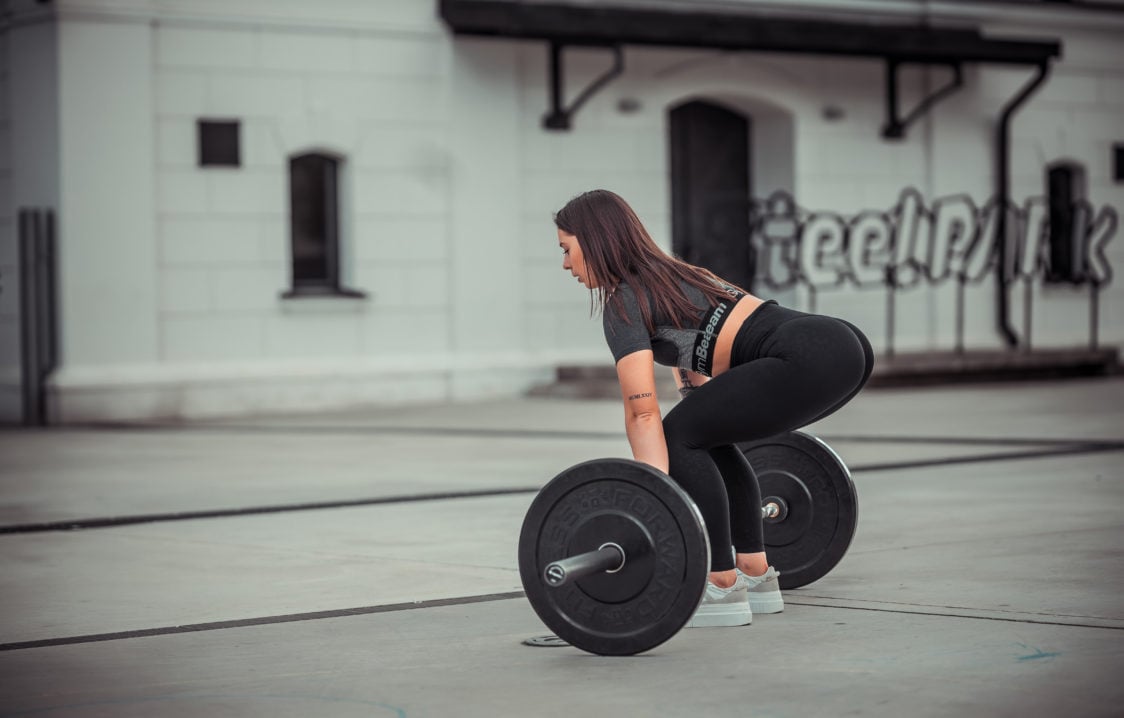
9 best exercises for glutes and legs
Using the exercises discussed in this article, you will be able to comprehensively train your buttocks (gluteus maximus gluteus medius, gluteus minimus), quadriceps, hamstrings, inner thighs as well as your calves. Most of these exercises are complex, meaning they will also engage your core, back or arms while performing them. All of these all ideally performed in the gym, however, if you do have a barbell with weight plates, dumbbells, kettlebells or a powerbag at home, you will also be able to work out from the comfort of your own home.
With each of these exercises, focus on performing with proper technique, and on activating your core. If you wish to support your knee stability some more, consider using neoprene knee wraps. When performing squats or deadlifts with heavy loads, you may find an exercise belt of great help, as these are designed to strengthen and support your core and lower back area.
1. Barbell Back Squat
- Starting position: Set your barbell with adequately chosen weights upon a squat stand at about the height of your collarbones. Stand underneath the barbell with your feet roughly shoulder-width apart. Position yourself so that the barbell sits behind your neck and grab it with both hands next to your shoulders with your elbows pointing down. Activate your core, remove the bar from the rack and take a step back.
- Execution: Inhale and move your pelvis back and down into a squat. Choose the depth of the squat so that you manage to maintain the natural curvature of the spine and are able to rise from this position. The axis of the knee, ankle and toe of the foot remains in one plane. Exhaling, straighten back up in a smooth motion by activating the muscles of the buttocks and the front of your thighs. Follow by another repetition. After completing the set, place the barbell back onto the rack.
- Common mistakes: Arching the back, insufficient range of motion, leaning forward, turning the knees in, unevenly distributed weight, tiptoeing or heeling, excessive or insufficient load on the barbell.
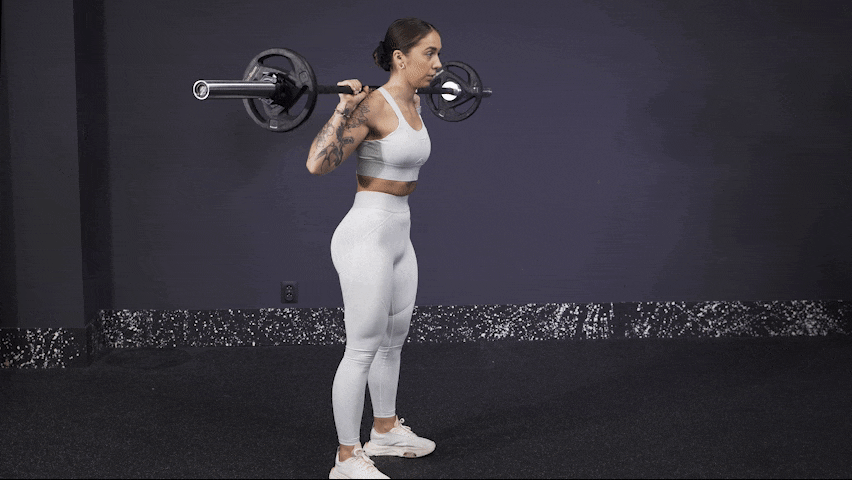
Further modifications of the exercise:
1. Dumbbell Goblet Squat
Weighted squats can also be performed using a simple dumbbell. Grasp it by one side (the weight section) and lift it up to the front of the chest so that it is parallel to the body. Keep the dumbbell in this position and perform the squat the same way you would with a barbell.

If you want to learn more about how to perform squats properly, don’t miss out on our article Squats: Benefits, Proper Execution and the Most Effective Variations for both Home and the Gym.
You might be interested in these products:
2. Dumbbell Reverse Lunge
- Starting position: Stand with your feet hip-width apart. Take one dumbbell into each hand and hold them by your side with your arms outstretched.
- Execution: Inhale, shift your weight to one leg and take a controlled lunge back with the other. Get to a depth in which your thigh is at about 90 degrees angle with your calf at the knee, or even deeper. You may lightly touch the mat with the knee of your back leg. Exhaling, return to the starting position by activating the muscles of the front of your thighs and buttocks. Perform your next lunge with the other leg.
- Common mistakes: Insufficient range of motion, leaning forward, knee rolling in, uneven weight distribution, poor movement coordination.

Further modifications of the exercise:
1. Forward Lunge
You can also try performing Forward Lunges. This exercise is performed the same way you perform the Reverse Lunge, except instead of stepping back, you step forth.
2. Barbell Reverse Lunge
Another modification you can make use of is performing the lunges with a barbell. Place it on the power rack and make sure you load up an adequate weight using the fitting weight plates. Position yourself behind the barbell so that it rests upon your back, grab it by the sides by your shoulders, and perform the same back step as when exercising with dumbbells.
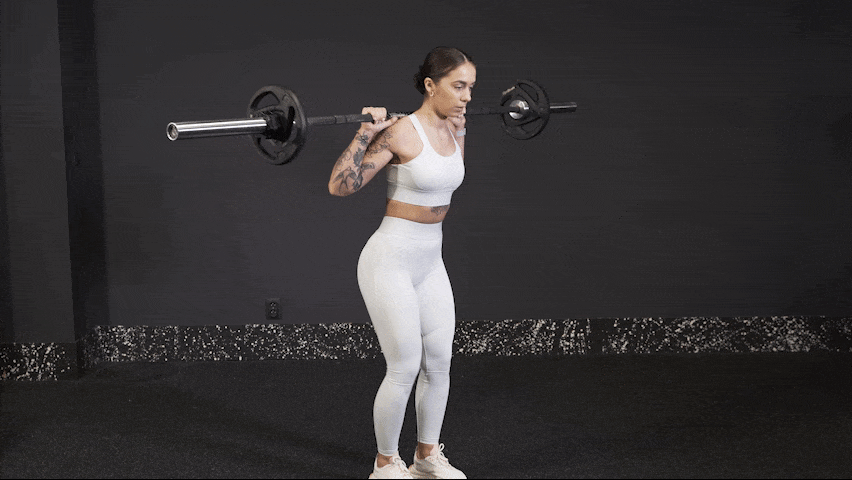
3. Dumbbell Bulgarian Squat
- Starting position: Stand in front of the workout bench with your feet hip-width apart. Take one dumbbell in each hand and place instep of one foot on top of the bench.
- Execution: Bend the knee of the front leg with an inhale, performing a stationary lunge. In the bottom position, you may lightly touch the mat with the knee of the back leg. Straighten back up with an exhalation and follow with the next repetition. After finishing a set, switch your legs and perform another set on the other side.
- Common mistakes: Insufficient range of motion, poor coordination of the movement, excessive leaning forward.
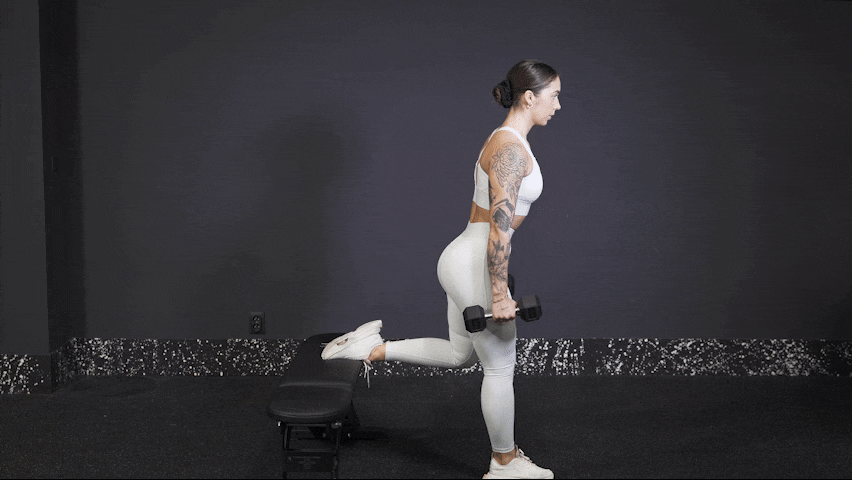
Further modifications of the exercise:
1. Barbell Bulgarian Squat
Bulgarian squat can be also performed with a barbell or a regular or adjustable water powerbag placed on your back.
4. Barbell Romanian Deadlift
- Starting position: Stand in front of an adequately loaded barbell with your feet hip-width apart. Grab the barbell with both hands approximately at the width of your shoulders. Straighten up and hold the bar in front of your thighs with outstretched hands.
- Execution: Move your pelvis back with an inhale, and lean forward in a controlled manner. Maintain the trajectory of the barbell closely in front of your legs. Try extending the trajectory all the way towards your ankles, but keep in mind that your back has to stay in its natural curvature, and your head in line with your spine. Straighten up with an exhalation, contracting your hamstrings and glutes. Follow with next repetition.
- Common mistakes: Insufficient range of motion, curving of the back, uncontrolled motion
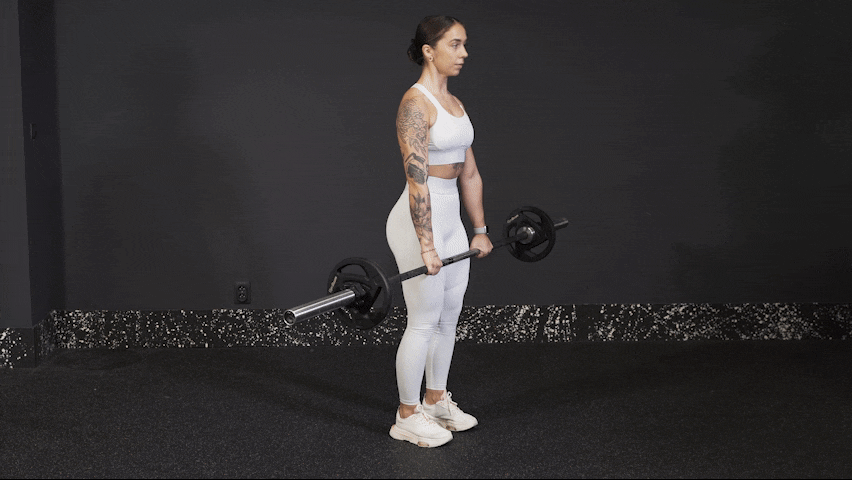
Further modifications of the exercise:
1. Dumbbell Romanian Deadlift
For this exercise, the barbell can also be substituted with a pair of dumbbells. Simply grasp the dumbbells with outstretched arms in front of your thighs and perform the exercise the same way you would with a barbell.
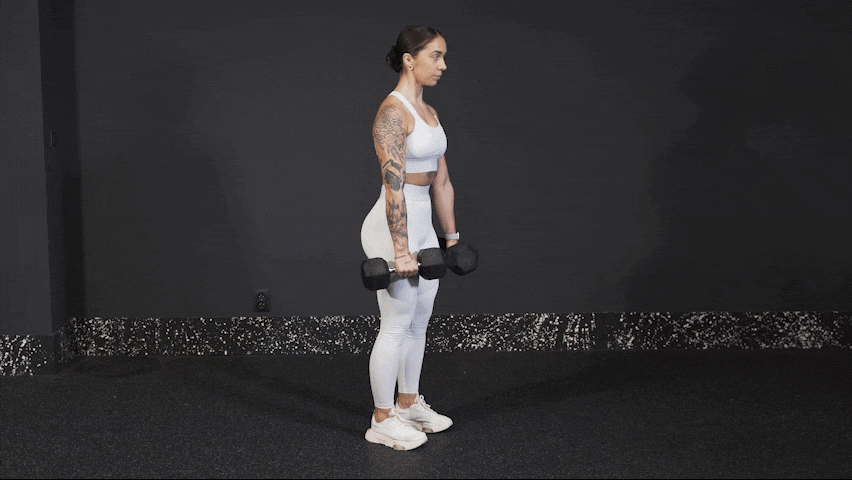
2. B-Stance Romanian Deadlift
This modification allows you to focus on the proprioception of glutes and leg muscles one leg at a time. Place one leg a few centimetres ahead of the other and lift the heel of the back foot up. Grasp the dumbbells in both hands, maintaining them on the sides of your thighs, shift your weight on the front foot and perform the exercise the same way you perform its basic variant. Switch legs after finishing the series.
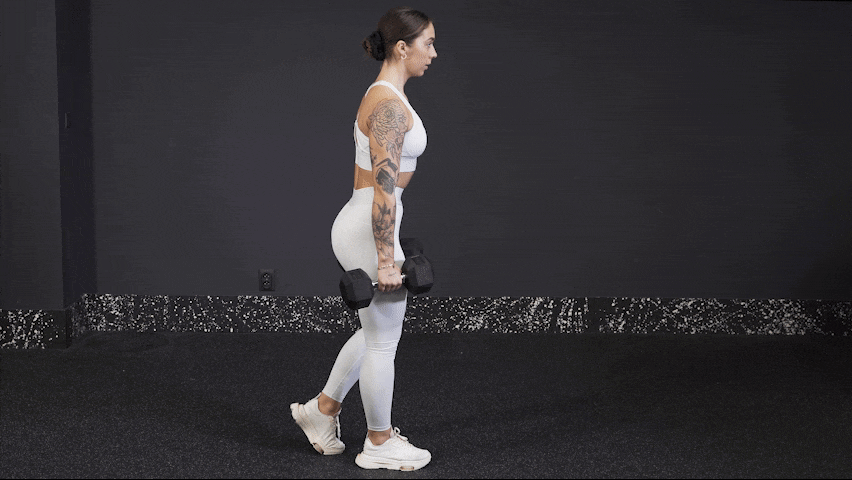
5. Sumo Deadlift
- Starting position: Stand in front of a loaded barbell with your feet slightly over shoulder-width apart. The toes and knees point to the sides. Bend your knees and lean forward towards the barbell, maintaining your back in its natural curve and your head in line with your spine. Grasp the barbell with both hands using an overhand or an alternating grip (one hand overhand, the other underhand). The width of the grip should be about the width of your shoulders, or slightly narrower.
- Execution: Gradually straighten up as you breathe in and activate your glutes and thigh muscles. First straighten your knees and follow up by straightening your torso in a smooth, continuous motion. Maintain the trajectory of the bar closely in front of your legs on the way up. Follow with another repetition.
- Common mistakes: Rounding of the back, uncontrolled movement, insufficient range of motion.

Further modifications of the exercise:
1. Dumbbell Sumo Deadlift
Sumo deadlifts can also be performed using a pair of dumbbells instead of a barbell. Grasp the dumbbells with arms outstretched in front of your pelvis. You can either hold them in a line, or with the handles pointing towards you. Perform the same as with a barbell.
6. Barbell Deadlift
- Starting position: Stand in front of a loaded barbell with your feet about hip-width apart, the toes of your feet pointing forward. Bend your knees and lean forward towards the barbell so that your back remains in the natural curve and your head in line with your spine. Grasp the barbell with both hands using an overhand grip or an alternating grip in case of a heavy weight load (i.e. one hand overhand, the other underhand). The width of the grip should be about the width of your shoulders, or slightly wider.
- Execution: Gradually straighten up as you breathe in and activate your glutes and thigh muscles. First straighten your knees and follow up by straightening your torso in a smooth, continuous motion. Maintain the trajectory of the bar closely in front of your legs on the way up. Follow with another repetition.
- Common mistakes: Rounding of the back, uncontrolled movement, insufficient range of motion.

Further modifications of the exercise:
1. Dumbbell Deadlift
You can also use a pair of dumbbells instead of a barbell. Grasp the dumbbells with your arms stretched out in front of your pelvis, handles pointing towards you. Make sure the trajectory of the weights on their way up and down flows closely to your legs.
2. Kettlebell Deadlift
This exercise can also be performed with one or two kettlebells. If you are using a single kettlebell, assume a wider stance, place the kettlebell in between your feet and grasp it by the handle with both hands. If you’re using two kettlebells, maintain a more narrow stance, and place the kettlebells on the outsides of your feet. Grasp them by the handles and lift them up alongside your legs.
7. Barbell Hip Thrust
- Starting position: Sit down on the floor and rest your upper back on the edge of a bench. Place the loaded barbell over your pelvis and then grasp the bar with both hands by your hips. Keep your feet planted on the floor at the shoulder width and your head in line with your spine.
- Execution: Lift your pelvis up in a smooth, controlled motion by activating your glutes and thighs as you inhale. In the upper position, your pelvis should be at the level of your knees. Once there, focus on contracting your glutes. Hold for one or two seconds and then drop your pelvis back down, again in a smooth, controlled motion. Follow with next repetition.
- Common mistakes: Arching of the hips in the top position, neck twisting, uncontrolled movement, insufficient range of motion.
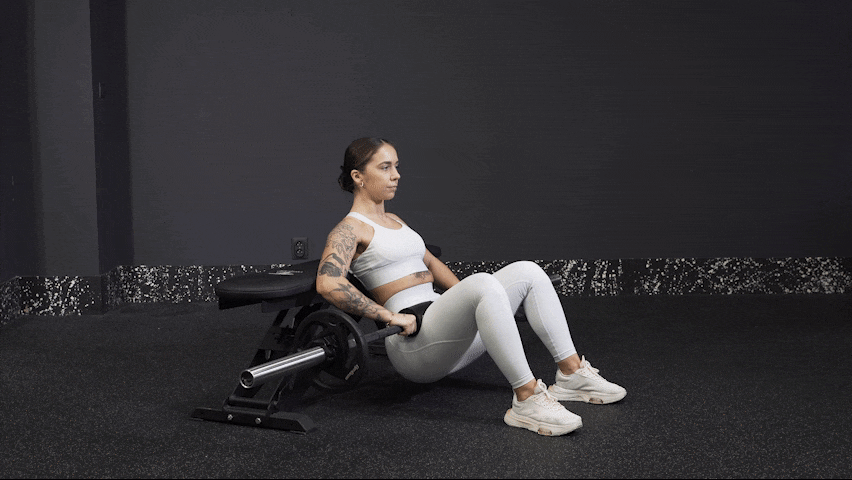
Further modifications of the exercise:
1. Kettlebell Single Leg Hip Thrust
This exercise can also be performed with a single leg at the time. You can do so with a kettlebell placed upon your hips the same way you would place a barbell. Grasp it with both hands by the handle. Then shift your weight onto a single leg while straightening the other one as you point it away from the centre of your body. Lift your pelvis and the straightened leg by activating your glutes. When finished with one series, follow up with another series for the other leg.
2. Hip Thrust Machine
Some gyms may offer a machine intended specifically for hip thrusts.
8. Cable Kickback
- Starting position: Stand with your feet hip-width apart facing the pulley machine. Grab an ankle strap adapter and attach it to a low-set pulley. Wrap the strap around your ankle, grasp the handle of the machine and place the other hand at your hip. Bend your knees slightly and lean forward. The back remains in a natural curve and the head stays in line with your spine.
- Execution: Breathe in and then exhale as you lift the working leg up and behind you. The leg remains slightly bent. In the upper position, focus on the contraction of the gluteal muscles. Hold for a second or two, then bring your leg back down and follow with another rep.
- Common mistakes: Insufficient range of motion, insufficient activation of the gluteal muscles, rounding back, uncontrolled movement, insufficient load.

Further modifications of the exercise:
1. Weighted Kickback
If you don’t have a pulley machine available, you can always perform this exercise using a pair of ankle weights. Attach the weight to your ankle, grasp a bar instead of a pulley machine handle, and perform the exercise as described above.
9. Dumbbell Step Ups
- Starting position: Stand in front of a bench or a plyometric box with your feet hip-width apart and take one dumbbell into each hand. Hold the dumbbells with your arms stretched out along your sides.
- Execution: Inhale, bend the knee of one leg and place its foot on top of the bench. Shift your weight towards the raised leg and step up on top of the bench with your other foot as you activate your thighs and glutes. Straighten up, and descend back from the bench in a controlled manner, one leg at a time. Follow up with another repetition, this time starting with the other leg.
- Frequent mistakes: Rounding of the back, uncontrolled movement, insufficient load.
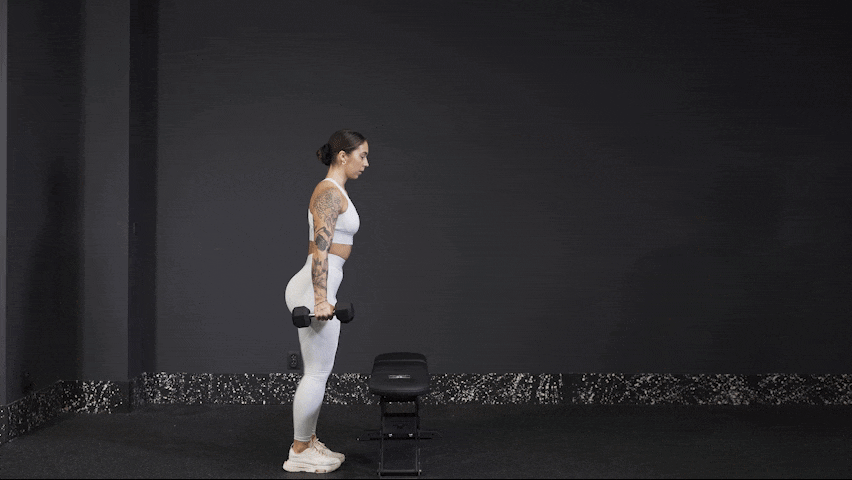
Further modifications of the exercise:
1. Kettlebell Step Ups
The same exercise may be performed using a pair of kettlebells, or with a barbell or powerbag placed on your back.
What’s next?
- If you’re looking for an effective booty workout routine that uses no weights, try using resistance bands. We’ll discuss how to use them in our article Get a Firm and Round Butt without Heavy Weights. Try Resistance Band Workout.
- If you prefer using a kettlebell, you can get inspired with 8 Best Booty & Leg Exercises with a Kettlebell.
- Do you want to learn how to properly choose your weight loads? Learn all about it in our article How Much Weight to Lift for Muscle Growth, Strength or Weight Loss?
- If you want to learn how to determine the ideal number of repetitions per set with your goal in mind, read up on the topic in our article How Many Reps Should You Do to Lose Weight or Gain Muscle?
- Trying to put on some muscle mass but it just won’t grow? Read our 10 Tips for Healthy Weight Gain.
- Want to calculate the amount of calories and macronutrients your body needs in order to lose weight, grow muscle or maintain a good condition? Get help with our Online Energy Intake and Macronutrient Calculator.
What’s the take home message?
If you want your leg day to be as effective as possible, make sure you include squats, lunges, deadlifts and other exercises we’ve just talked about. All of these will help you achieve a round booty and strong, toned legs. Always remember to focus on proper technique and muscular proprioception. Increase the weight loads you work with slowly and in reasonable increments. Plan your leg routine out twice or three times a week. When making your weekly training plan, consider the time your body needs for recovery of the muscles damaged after the training.
Did you find this article useful? If so, share it with your friends and help them get inspired to work on their lower body too.
[1] Burd, N. A., West, D. W. D., Moore, D. R., Atherton, P. J., Staples, A. W., Prior, T., Tang, J. E., Rennie, M. J., Baker, S. K., & Phillips, S. M. . Enhanced Amino Acid Sensitivity of Myofibrillar Protein Synthesis Persists for up to 24 h after Resistance Exercise in Young Men. – https://doi.org/10.3945/jn.110.135038
[2] Krzysztofik, M., Wil k, M., Wojdała, G., & Gołaś, A. Maximizing Muscle Hypertrophy: A Systematic Review of Advanced Resistance Training Techniques and Methods.– https://doi.org/10.3390/ijerph16244897
[3] Schoenfeld, B. J., Grgic, J., Van Every, D. W., & Plotkin, D. L. Loading Recommendations for Muscle Strength, Hypertrophy, and Local Endurance: A Re-Examination of the Repetition Continuum.– https://doi.org/10.3390/sports9020032


Add a comment